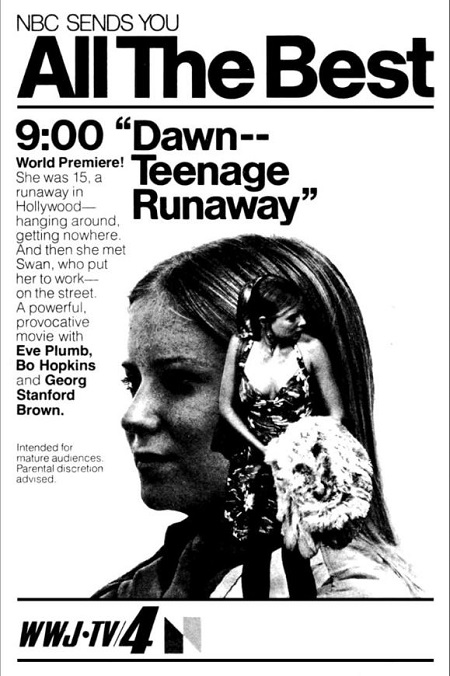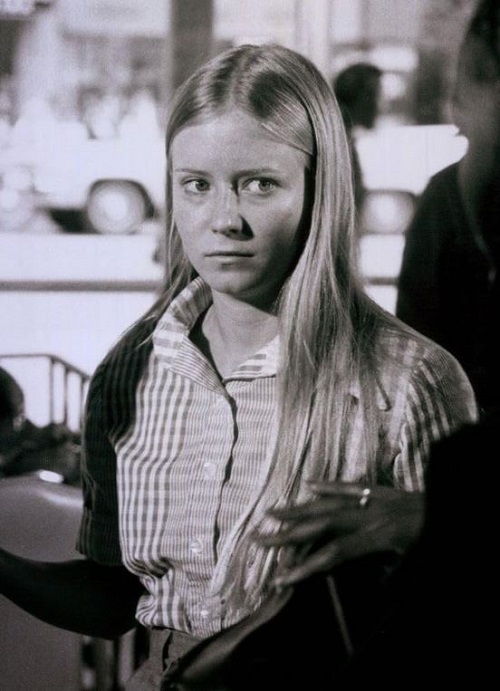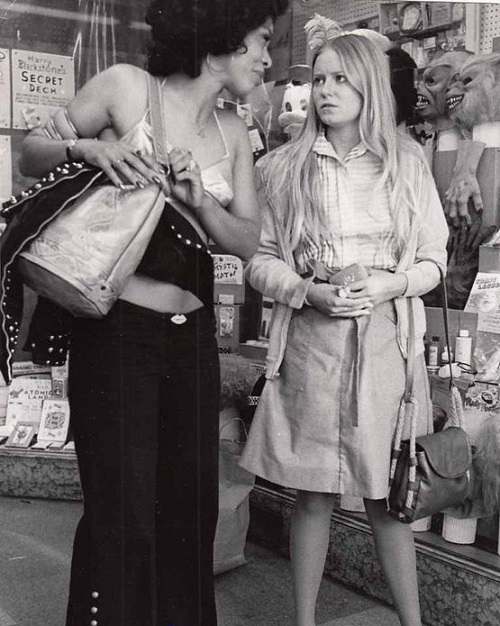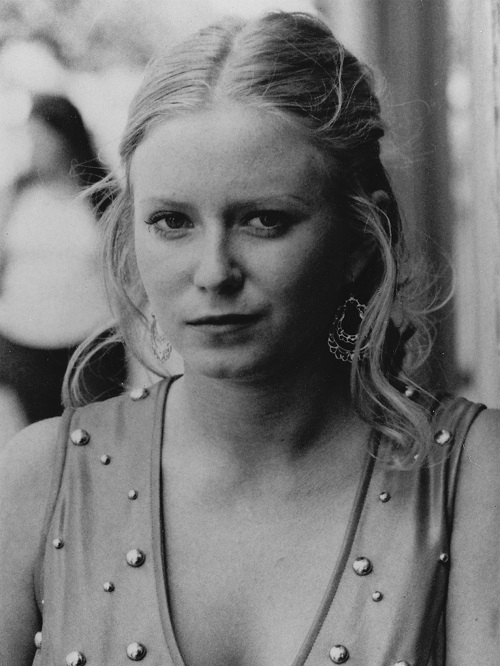By Erin Free
In this regular column, we drag forgotten made-for-TV movies out of the vault and into the light. This week: the 1976 cautionary tale Dawn: Portrait Of A Teenage Runaway, starring Eve Plumb, Leigh McCloskey, Lynn Carlin, Georg Stanford Brown and Bo Hopkins.
With a captive audience of American families, often glued to their TV sets after their evening meal, the vintage telemovie of the 1970s and 1980s unsurprisingly and very frequently opted to play on their deepest fears as an audience hook. As a result, there were cautionary tales aplenty, which served as dire warnings to concerned, wide-eyed parents and as exploitative entertainment to younger audiences excluded from more extreme, truly exploitative content on the big screen. This tactic resulted in big ratings for the major US networks, and there was nothing short of a cavalcade of “teen panic” telemovies which depicted adolescents tempted and lured into all manner of bad behaviour while their worried parents unravelled dramatically on the sidelines.
There were telemovies about the dangers of hitchhiking (1979’s Diary Of A Teenage Hitchhiker), the terrifying lure of drugs (1973’s Go Ask Alice, 1977’s The Death Of Richie), the all-too-near temptation of alcohol (1975’s Sara T: Portrait Of A Teenage Alcoholic, 1980’s The Boy Who Drank Too Much), the potentially corrupting presence of troublesome school gangs (1979’s The Survival Of Dana), the perils of teen pregnancy (1987’s Daddy), the nightmare of serious eating disorders (1981’s The Best Little Girl In The World), the ever-present spectre of child abuse (1981’s Fallen Angel) and rape (1978’s Are You In The House Alone?), and many more forms of existential and not-so-existential threats.

One of the most famous of these “teen panic” telemovies is unquestionably 1976’s Dawn: Portrait Of A Teenage Runaway, which posited, in no uncertain terms, what could happen to a fifteen-year-old girl if she ran away from her small hometown and ended up on the streets of Los Angeles. Incredibly prurient and sordid in that typically vintage telemovie way – namely, through the art of not actually showing much, but suggesting a whole hell of a lot – the notoriety of Dawn: Portrait Of A Teenage Runaway was instantaneous, largely through its very confrontational act of central casting.
The eponymous adolescent in this drama was played by young actress Eve Plumb, who had achieved fame as perennially put-upon middle daughter Jan Brady in the essential, squeaky-clean sitcom The Brady Bunch, which had ended its run two years previously. In Dawn: Portrait Of A Teenage Runaway, Eve Plumb engages in the kind of (off-screen) unwholesome behaviour that would have prompted a very long lecture from best-dad-in-TV-history Mike Brady.

Dawn: Portrait Of A Teenage Runaway is one of the most dramatic instances of onscreen image shake-off you’ll ever see, and on top of that, the telemovie was also part of the reason why Eve Plumb didn’t appear in the much-maligned The Brady Bunch Variety Hour, the bizarre musical offshoot of the popular sitcom produced “out of house” by Sid & Marty Kroft after the series proper had ended. This led to Plumb’s role being recast with fill-in actress Geri Reischl, who would then forever be known as “fake Jan” in the long and twisting annals of The Brady Bunch. “What happened for me was very fortunate,” Eve Plumb told Remind Magazine. “Dawn: Portrait Of A Teenage Runaway was the giant leap that sent me from being Jan Brady to being an adult actress. By that time, I had already been in high school for several years. I was already becoming an 18-year-old. I was already very nearly adult. I was very excited to play something very different and very challenging.”
First broadcast on major US network NBC on September 27, 1976, the director on Dawn: Portrait Of A Teenage Runaway was the up-and-coming Randal Kleiser, who would helm another essential telemovie that same year with The Boy In The Plastic Bubble before going on to direct big screen hits like Grease and The Blue Lagoon. The writer was Unsung Auteur Dalene Young, who made her debut with the project, and would later go on to pen the superior female-focused 1980 teen flick Little Darlings and the 1983 drama Cross Creek. Both director and writer here have an obvious affinity for teenage characters, and a bent for treating their problems with sensitivity and seriousness; their skill-sets are nicely showcased on Dawn: Portrait Of A Teenage Runaway, and help to pull back the reins on the telemovie’s obviously exploitative and salacious elements.

Dawn: Portrait Of A Teenage Runaway begins with fifteen-year-old Dawn Weatherby (Eve Plumb) desperate to get out from under the influence of her loud, blowsy, boozy mother (Lynn Carlin in good form) and leave her quiet, nothing-happening hometown. Dawn jumps on a bus for LA, and almost as soon as she gets off, this hopeless naif is drawn into a world of sordid vice. Hungry and homeless, Dawn is taken in by the sweet, soulful Alexander (Leigh McCloskey), a likely bisexual young man who subtle and not-so-subtle hints suggest is involved in sex work. Alexander tries to protect Dawn, but the fifteen-year-old (yes, fifteen-year-old!) is soon working as a prostitute under the very nasty influence of pimp Swan (Bo Hopkins). Alexander makes a play at getting Dawn to go straight with the help of her parole officer Donald Umber (Georg Standford Brown), but this once-innocent teen may now be too hooked on “the life” to change…
Because this is, of course, a telemovie, there is no sex, nudity or extreme violence in Dawn: Portrait Of A Teenage Runaway but the shocks still register, and register hard, principally because of the film’s willingness to dig right into its confrontational concepts. Dawn doesn’t just flirt with the idea of becoming of a prostitute, she actually becomes one. This is made even more shocking by her initial childlike sense of innocence, which is showcased in a very unsettling scene in which Dawn picks up her first “client”, surprisingly played by frequent TV guy “nice guy” William Schallert. The film is filled with many such scenes, and they’re incredibly uncomfortable to watch. And while it doesn’t quite do for LA what that same year’s Taxi Driver did for New York, the Hollywood Boulevard shown in Dawn: Portrait Of A Teenage Runaway (with The Runaways’ “Cherry Bomb” as aural accompaniment, no less!) is suitably grimy and vice-ridden.

The film is occasionally marred by melodrama, especially in the personage of its two youthful lead characters, who are both prone to moments of very big emotion. Though always engaging, Eve Plumb is sometimes a little shrill, especially as her character’s likeability ebbs away over the course of the film. Leigh McCloskey (who would go on to a long career in TV) captures Alexander’s earnestness well, but as Dawn’s behaviour becomes so increasingly erratic that you can’t help but question his dedication to her. The great character actor Bo Hopkins, meanwhile, completely checks his trademark brand of laconic cool at the door, and plays the cruel, bullying pimp Swan as a pure, unbridled arsehole of the very first order, and he’s utterly chilling in the process.
Seamy and sordid, Dawn: Portrait Of A Teenage Runaway still packs a punch today in its unflinching look at what can happen to an innocent teen in the big city. The central relationship between Dawn and Alexander is certainly melodramatic, but it’s also touching in its unusual intensity and earnestness. A prime example of telemovie “teen panic”, the affecting and arresting Dawn: Portrait Of A Teenage Runaway was a huge ratings success, prompting both a novelisation tie-in and even a sequel in the form of 1977’s Alexander: The Other Side Of Dawn, which digs deeper into the backstory and continuing misfortunes of its eponymous character.

And importantly, Dawn: Portrait Of A Teenage Runaway also changed the way the world looked at Eve Plumb. “It was a really great opportunity,” the actress told Remind Magazine. “It was very popular. It did really well in the ratings. I haven’t faced a lot of typecasting. I’ve been fortunate enough to continue to be cast in different roles. Nobody has seemed to put me in a niche.”
Availability: Dawn: Portrait Of A Teenage Runaway is relatively easy to find online, but only in a fairly poor presentation, with blurred, tenth-generation images and sludgy sound. The fact that a telemovie of this level has never been properly released is nothing short of mind-boggling.
If you enjoyed this review, check out our other vintage telemovies Young Love, First Love, Escape From Bogen County, The Death Squad, Hit Lady, Brian’s Song, The Defiant Ones, A Cry For Help, Trilogy Of Terror, Policewoman Centerfold, Smash-Up On Interstate 5, Something Evil, Savage, A Step Out Of Line, The Boy In The Plastic Bubble, The Dirty Dozen: Next Mission, A Very Brady Christmas, The Gladiator, Elvis, The Rat Pack, Silent Victory: The Kitty O’Neil Story, Terror Among Us, The Hanged Man, Hardcase, Charlie’s Angels: Angels In Vegas, Vanishing Point, To Heal A Nation, Fugitive Among Us, To Kill A Cop, Dallas Cowboys Cheerleaders, Police Story: A Chance To Live, Murder On Flight 502, Moon Of The Wolf, The Secret Night Caller, Cotton Candy, And The Band Played On, Gargoyles, Death Car On The Freeway, Short Walk To Daylight, Trapped, Hotline, Killdozer, The Jericho Mile, Mongo’s Back In Town and Tribes.





